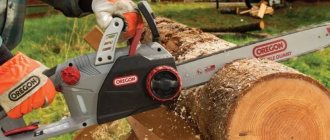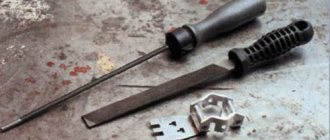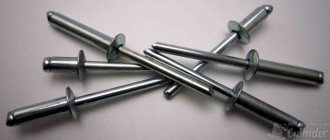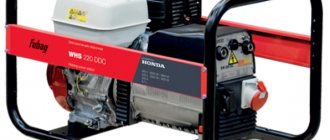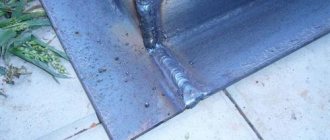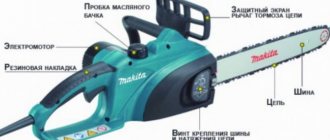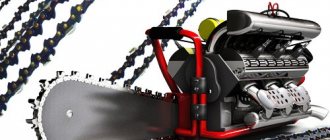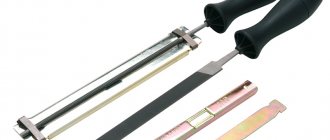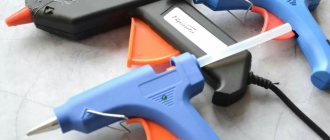In those moments when you don’t have the operating instructions for a chainsaw at hand, and you can’t independently determine the markings of its cutting set, information tables come to the rescue, designed not only to simplify the life of owners of gas-powered tools, but also to save them from possible mistakes that can be made by choosing unsuitable dimensions of the tire or the chain blade itself.
Choosing the best chain for a chainsaw
Choosing a suitable chain for a chainsaw is very important. Not only the efficiency of the work depends on this, but also the ability to efficiently cut different species and varieties of wood. The main problem is that even masters do not always remember which particular circuit
you need to take it for your own saw. This may be due to the fact that the wear of the chain, with constant seasonal use, takes a couple of years.
The saw set itself consists of two parts: a bar and a guide chain. With constant or incorrect use, the teeth begin to become dull and need to be sharpened. But after some time, there will still come a moment when the chain
will require replacement. Then it will be useful to choose the right option, based on the pitch, length, material, different characteristics of the teeth and the rest.
Shank thickness
Another point that must be taken into account when choosing chains for chainsaws is the thickness of the shank. The tail part is a section of the chain that is located inside the tire. The thickness of this part can be different for many chains, so you should choose based on the power of the chainsaw. Simply put, the smaller the installed tire, the thinner the shank should be.
In parallel, you need to take into account the step. The latter, in this case, remains the most important parameter. Next you can see a table from which you can quickly understand what thickness of the shank you need to select.
| Step | Thickness |
| 0,25 | 1.1 mm |
| 0,325 | 1.3 mm |
| 0,375 | 1.5 mm |
| 0,404 | 1.6 mm |
| 0,75 | 2 mm |
Using this easy table, you can quickly understand how the shank thickness depends on the chain pitch. But that's not all. There are still a few things to consider.
About the teeth
The teeth have a very specific design. To learn how to work with a chain and sharpen it correctly, you should know the basic material. In terms of its specificity of operation, a chainsaw bears little resemblance to a plane. Because of this, you need to know which specific parts require care.
The design of the cutting-working links is not so common. Every link
It has:
- vertical end and upper horizontal edges of the blades;
- spatula;
- base with a hole for the axle;
- limiter for the set depth of cut.
The quality of cutting materials depends on the presence of such parts and components.
Cutting depth
Huge teeth provide the deepest cuts in one go. Accordingly, the depth of cut directly affects the speed of work. It is important to note that this parameter seriously affects the engine and the chainsaw
may not be able to handle the load.
The height of the links determines the strength of the teeth. The more, the less high-strength they are. According to the standard, they are made in two versions: 0.635 and 0.762 mm. They are classified as low-profile if the profile is small, and if large - as high-profile. The speed of sawing wood directly depends on the depth of cut.
Other recommendations
- If grams are not important to you, then do not select lightweight chains for your bike. They do not have more resources, but the price is higher. Externally, light chains can be identified by perforated side plates and hollow pins (axles).
- Pay attention to the color of the metal. A slight yellowish tint, like a black tint, indicates the low quality of the chain. High-quality bicycle chains are available in matte gray (Shimano, Campagnolo, SRAM) or gold (KMC).
- Don't ruin expensive cassettes with cheap chains. It makes absolutely no difference whether the best Shimano derailleurs for a bicycle are installed or the worst, but the cassette should not be a class higher than the chain. Otherwise, you will spoil the stars ahead of time. It is possible to do the opposite, but the economic justification for the move is questionable.
Types of chains for chainsaws
First, you should understand the types of chains for chainsaws before you start choosing them.
The types of saw sets are as follows:
- household;
- semi-professional;
- prof.
Not only the quality and material used, but also other characteristics of the chain depend on the design features. In your choice, you need to rely more on the properties of the chainsaw. Otherwise, an incorrectly selected saw set can place a very heavy load on the engine and the owner will soon need to make a complete repair.
Saw chains come in the following types:
- Chipper ones are universal. They are used in everyday life and personal construction. They are also chosen for sawing logs into planks by the craftsman. Typically, the latter install them on LOGOSOL type sawmills. Having the correct sharpening angle (approximately 10°) allows the chains to cut quickly along the wood grain, which is why they are especially valuable in sawmills.
- Chisels - show themselves well in cross section. More often used by specialists. The chisel chain copes well with cutting across. But when sawing lengthwise, it is less effective than chipper, even with proper sharpening.
READ Husqvarna 135 Chain How many Links
The differences between chains lie in the types of teeth, which, depending on their shape, can have a significant impact on the possible performance characteristics.
There is also a separate type of chains for chainsaws, they are called special. These saw sets have a special purpose - working with concrete, aerated concrete, or carrying out rescue operations. The design of the teeth is also different, but most importantly, the difference is in the materials used. You can saw concrete slabs without much effort using a Pobedit-tipped chain. But they are not cheap. So for an ordinary tradesman, purchasing them may simply be impractical.
The base of most standard chains is chromium-nickel steel. To work with hard wood or frozen wood with sufficient density, it is useful to choose the option with carbide links. The highest price of which is their main drawback. And in order to sharpen them correctly, you will need equipment equipped with corundum attachments.
What parameters should you use to choose a chainsaw chain?
Depending on the main characteristics of the chainsaw, craftsmen choose a chain
. Work devices also differ in their features, because they are designed to perform different tasks. That is why the replacement chain must be selected correctly, as well as the equipment for sharpening it. What characteristics need to be taken into account in all this?
Pitch is one of the most important characteristics. It is precisely this that is usually used as a guide when choosing chains for chainsaws, in contrast to round-link chains, in which the caliber is of greatest importance. It is possible to measure your step without the help of others. To do this, you need to apply a ruler in the direction from the first to the third link of rivets. Data is expressed in inches. Probable output, and therefore productivity, are directly dependent on the set value.
Standard step sizes determine the purpose of the tools and their scope of use (see table).
Using this table, you can understand what type of saw set the user needs at this point in time, based on the pitch of the tool.
Tire length. Teeth sequence
The teeth on a chain can be placed in different ways.
How to determine what kind of chain you have? How to pick up a saw chain?
Buy chains
very cheap — ^^^^^^^^^ Subscribe! In this we will learn to determine which one is in front.
Buying a tire is not an easy task
When purchasing a tire that is not bad from a unique model, there is a high possibility that the old chain and the new tire will not fit together in any way. Ideal option: try on all three main components - a bar/ chain
and, practically, the gas-powered tool itself.
The length of the chainsaw bar is the length of the saw bar, as is important when choosing a chain. A slight difference, sometimes not even noticeable to the eye, of just one link can be critical for the entire assembly: the chain either won’t fit at all or will sag.
The next point: different chainsaws are designed for different widths of tire grooves, and accordingly, the drive links are designed for use with different tires. The wide grooves of the chainsaw are designed for a chain that can withstand important loads, characterized by high quality workmanship and operating efficiency. When choosing a chain, it is important to check the possible width for a given chainsaw model.
Keys and combination lock
Level and cylinder locks. Old bicycle locks with cylindrical keys, called lever locks, were not very reliable. With some effort, they could be opened using only the tip of a ballpoint pen.
It is assumed that cylinder bike locks, which have flat keys, are more reliable. Although for expensive items it does not matter what type their internal mechanism is. Locks assembled with a high level of secrecy will in any case be burglar-resistant.
Code lock. In terms of ease of everyday use, a combination lock for a bicycle is the leader, since when using it, you do not need to carry a key with you. The main thing is not to forget the installed code.
Citadel code lock in a shell with frame mounting
Although all combination locks have four rotary dials and require one correct combination out of 9,999 possible to open, experienced attackers can open some, not the best ones, in less than a minute. You can see what has just been said by watching the following video.
The video most likely shows the breaking of low-quality locks, since most expensive models do not make a clicking sound when they hit the desired number. With a reliable code grip, a noticeable increase in the free stroke of the rod does not mean that you guessed one of the numbers correctly. Some absent-minded cyclists, having forgotten the personally set code, have been unable to open their lock for the second year. Now they have only one choice - to cut the cable.
How to Count Chainsaw Chain Links AURAMM.RU
a chainsaw chain without the help of others
?
- Equipment and rules of use
- Tools needed
- How to remove rivets?
- Connection of links
- The Bad Consequences of Improper Chain Repair
- Contact an experienced welder
- How to make the right rivets using an electric drill?
- Why do chains stretch?
Almost every suburban home owner owns a chainsaw. And we don’t even have to talk about residents of rural areas: such a tool is a pressing need for them. And asks for a chainsaw
to yourself with careful business and timely service. All maintenance rules are correctly stated in the instructions.
Preparatory work
In the package version of making a knife from a chain, the product is suitable for various mechanisms: a motorcycle, a car, a bicycle or a chainsaw. Having decided on the manufacturing method, you need to prepare the tools and materials:
- an anvil, two hammers - large and small;
- oven or forge;
- vices, angle grinders with discs for various purposes;
- tetraboric acid (borax);
- Hydraulic Press;
- grinding machine;
- welding machine, steel chain;
- high carbon steel plate;
- motor oil and a container of water;
- drill, wooden block, epoxy glue;
- masking tape, sandpaper of different grains;
- Handle impregnation made from natural oils.
Knife from a chain. Tools and materials are professional in nature. From the very beginning it was stated that this was a job for experienced craftsmen. Beginners should not try this material. You need to start experimenting with simple preparations.
Instructions for making a knife from a chain
A distinctive feature of the batch forging process is the work with several metal plates. Having everything you need, you need to start the initial forging of the blade:
- Using a cutting wheel on an angle grinder, cut the chain into several pieces of equal length. Having folded them into a single form, using welding, we “grab” them to obtain a solid workpiece.
- A rod is welded to the resulting rectangle for ease of holding. Having warmed up the oven, place the workpiece in it and heat it to 1100-1200 °C.
- Once the metal has reached a bright red hue, remove it and sprinkle it generously with borax. This will allow you to more reliably fasten the pieces of the chain together and get rid of voids in the links. Place in the oven for further heating.
- We take it out again, sprinkle it with borax and quickly move to the press. With its help, we gradually compress the workpiece from all sides. We monitor the temperature; when the part has cooled down, go back into the oven. The process performed by the press will help get rid of voids in the workpiece and forge weld it into a monolith.
- After making sure that the welding is sufficient, use a large hammer to flatten the workpiece into one plate. Cool the product in air, cut off the rod using an angle grinder. And with the same tool we halve the plate.
- Between the resulting halves we lay carbon steel, sprinkling the layers with brown. We carefully “grab” it with welding and return the rod to its place. Place in the oven and heat until bright red. Having taken out the plates, we forge them with a large hammer. The plates must be welded together using the forging method.
Knives from a chainsaw chain.
Basic circuit parameters
Marking a chain implies the presence of the following characteristics:
- Step:
- “0.325” is the most common small step size, which is used in semi-professional, non-household chainsaws with low power. The standard power value for such a step ranges from “0.325” to “3 hp”, as annoying as it may sound, no higher than “3.5 hp”. When working with this type of chain, cutting occurs more smoothly, more comfortably, without “breaking” the workpiece.
- “0.375” (“3/8”) – applied to chainsaws with a power of “4 hp”. This type of chain is used when sawing wood of medium and not small thickness.
The accuracy and quality of the cut created depends on the pitch value. When it is not important to achieve high-quality work when working with a chainsaw, the accuracy of the cut is of particular importance. Therefore, take for a low-power chainsaw in the world. Chains with the number of chain links. For this purpose, it is imperative to take into account the dependence of the step on the dissolution of wood according to the markings applied in advance.
Adjustment and repair
A bicycle chain is a simple design. This element is made of metal and consists of individual links connected to each other. The design of each link includes two internal and external plates, a pin and a roller. The size of the chain depends on the size and number of these elements. The bicycle chain not only participates in the movement of the vehicle, but also allows you to change the speed of multi-speed bicycles using multi-speed chains.
Before starting repair work, it is necessary to remove the chain, remove dirt and old oil from it. For cleaning, you can use kerosene or other preparations intended for this purpose, for example, VD-40.
How to count the teeth on a chainsaw chain
OREGON is a large manufacturer and one of the main innovators in the field of saw chains. We believe that for a perfectly completed job, it is important not only the quality of the tool, but also its competent selection. Let's take a look at what you first need to pay attention to in this matter in order to make a choice that will meet your needs.
This is the distance between the axes of 3 adjacent rivets, divided by two. It should match the pitch on the saw's drive sprocket and the sprocket at the nose of the bar.
Pitch is measured in inches, the most common values are:
“325 is one of the most popular options, often installed on household and semi-professional saws of low and medium power; 3/8 – comes with a low profile for the most common lightweight saws and just 3/8 for massive professional saws; “404 – used on professional saws with a power of more than 5.5 liters. p., it is not economically feasible to install on low-power saws.
READ How to Start the Stihl Ms 180 Chainsaw
To choose the right chain for a chainsaw, taking this factor into account, just read the annotation - it will indicate what pitch it is designed for. Apart from some professional models, most saws are designed for one specific step.
They ensure the movement of the chain along the bar due to the clutch with the saw drive sprocket. They measure the length of the chain: it is equal to the number of leading links in the ring. To find it, just fold the ring in half, count the pairs of leading links and double the total. Also on the leading links there is a marking by which you can find the series of the product.
Measured at the shank of the drive link running inside the bar groove and should correspond to the thickness of the bar groove.
They are specifically responsible for cutting wood. They differ in shape, sharpening angle and width of chrome. In most cases, the following types are used: Chisel (chisel, super). The most brutal type of link, cuts quickly, but requires frequent sharpening and wears out faster; Get a chisel. Cutting is smoother, sharpening is required noticeably less often.
They retain lubrication and are responsible for the strength of the product.
Additional OREGON Engineering Solutions
Vibe-Ban – reduces vibration, increases operator safety and speeds up cutting. LubriWell – improves the distribution of lubricant along the length of the groove on the guide bar. LubriLink – increases connecting links and maintains lubrication. Witness Mark – simplifies the service. Its marks indicate the best sharpening angle for the horizontal edge of the cutter. Available on all chisel chains.
The number ninety-one represents a series of low-profile 3/8 pitch chains with a 1.3mm drive link width from OREGON. This is the most needed series from OREGON; its sales cover 70% of the market.
91P is the most popular economical option, with a minimum of engineering functions; 91VXL – premium class, impeccable price-performance ratio (armed with all the above-mentioned special engineering solutions); Multicut – designed to work in abrasive environments; SpeedCut (with a narrow cut) - a new product in two thousand and seventeen, characterized by increased cutting speed and smoothness; PowerSharp is a unique self-sharpening option, an innovative development from OREGON. Currently used, first, in conjunction with the heavy-duty 15-amp chain saw CS1500 from OREGON - the world's only electric saw with a self-sharpening function.
Often, when buying a chain, buyers ask, for example, “a chain for a 30 5 cm bar” or “a chain for 20 5 teeth.” The request, frankly speaking, is incorrect and here’s why. To choose the right saw chain, you need to accurately find its characteristics.
Preparing a fuel mixture for a chain saw.
Since the majority of chain saws available to consumers are equipped with two-stroke engines that do not provide separate lubrication of rubbing parts, it is very important to prepare the correct fuel mixture during break-in. It is prepared from gasoline and two-stroke engine oil in a certain proportion recommended by the chainsaw manufacturer
What gasoline should I use for the fuel mixture?
The basis is gasoline with an octane rating of at least 90. For Russia, Belarus, Kazakhstan and other CIS countries, the optimal fuel option is AI-92. Avoid using questionable fuels, as well as using any additives that increase the octane number. Over time, additives lose their properties, and gasoline becomes of low quality.
Using fuel with a low octane number when running in and operating a chainsaw causes uneven engine operation and knocking. At the same time, there is an increase in engine temperature and an increase in the load on the main bearings. Imaginary savings most often lead to failure of the cylinder-piston group, requiring significant funds to restore it.
New chainsaw owners often have a question about what kind of gasoline to pour into the tool tank: leaded or unleaded? Leaded fuel is used to start an engine without a catalyst. If your saw has a catalyst (green gas tank cap), then use unleaded fuel.
What oil should I use in the fuel mixture, and in what proportions?
Two-stroke engine oil is used both for break-in and for continuous operation of the chainsaw. If you don’t want to take risks and experiment, then purchase the lubricant recommended by the tool manufacturers. As a rule, large companies produce fuel and lubricants for them to order. This allows the manufacturer of chain saws and other gas-powered tools to guarantee proper starting and trouble-free operation of their products.
Since branded oils for chainsaws Husqvarna, Stihl, Partner, Oregon, Jonsered are bottled from the same barrel, you can break in the tool with any of the following
In this case, it is very important to take into account the recommendations both in the instructions for oils and the recommendations of chain saw manufacturers. When using branded fuels and lubricants, when preparing the fuel mixture, follow the operating instructions for the gas-powered tool
| Recommended proportions of fuels and lubricants when preparing fuel | |||
| Break-in chainsaw | Proportion | Gasoline, (liters) | Oil, (liters) |
| Husqvarna up to 1.5 kW | 1:40 | 1 | 0,025 |
| Husqvarna over 1.5 kW | 1:50 | 1 | 0,020 |
| Stihl up to 1.5 kW | 1:40 | 1 | 0,025 |
| Stihl over 1.5 kW | 1:50 | 1 | 0,020 |
| Partner | 1:40 | 1 | 0,025 |
| Partner | 1:33 | 1 | 0,030 |
If branded oils are not available, you can break in a new chainsaw using third-party lubricants of the JASOFB or ISOEGB class. According to the instructions, the ratio of components is taken at the rate of 1:33. At the same time, the tool manufacturer does not recommend using four-stroke motor oils or two-stroke motor oils for water-cooled outboard engines, labeled as TCW.
The fuel mixture for a chainsaw to be run in should be prepared in a clean container intended for storing fuel and lubricants.
- Pour half the required gasoline into the container;
- Add required amount of oil;
- Gently mix the ingredients;
- Pour in the remaining gasoline and stir.
Chains for chainsaws, their types and sizes. 3. Number of links
The total number of links, both cutting and connecting, is calculated.
Now, it is quite clear that a “ chain with 20 5 teeth” is converted into a chain with 50 links, and a “chain with a 30 5 cm bar” can be either with a pitch of 3/8 inch or with a pitch of 0.325 inch, moreover, From different manufacturers, with the same chain pitch and bar length, the number of saw chain links varies. This is due to the location of the sprocket on the saw itself.
Chainsaw chain markings
Sources:
https://stankotec.ru/raznoe-2/kak-poschitat-zvenya-na-cepi-benzopily-kak-poschitat-zvenya-cepi-benzopily-%E2%80%A2-auramm-ru.html https:// vi-pole.ru/kak-poschitat-zubja-na-cepi-benzopily.html
Making the right choice
To begin with, the marking of the circuit, which indicates the basic information, is clarified. In addition to factual data, manufacturers often determine the quality indicator of their product by applying alphabetic and numerical designations.
The following products are popular:
- Shimano is a company from Japan that was the first to use dry lubrication;
- Compagnolo is an Italian company that cooperates with famous sports teams. Produces high-quality but expensive chains;
- SRAM is an American brand that was the first to use locks to connect links;
- KMS - produced in Taiwan, the quality is reminiscent of Japanese and American chains, but the cost is in an affordable range;
- Wipperman is a manufacturer from Germany that produces reliable but expensive chains;
- Tyazhmash is a Russian manufacturer, the products are wear-resistant and can withstand a load of 1,100 kgf.

